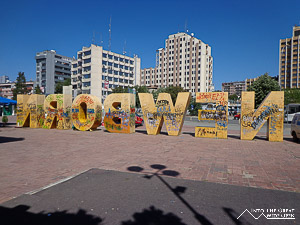Prizren and Prishtina, Kosovo
A Newborn Country
July 14, 2012
It's time to begin, isn't it?
I get a little bit bigger but then I'll admit
I'm just the same as I was
Now don't you understand
That I'm never changing who I am
- Imagine Dragons

In Prishtina, the capitol of Kosovo, the graffiti covered colorful concrete letters proudly proclaim the word NEWBORN. Following its disputed declaration of independence in 2008, Kosovo is now recognized by 91 United Nations members while other countries, China, Russia, and former CIS states still do not recognize Kosovo and consider it part of Serbia. Today Kosovo has a primarily Albanian population with the exception of Serb controlled areas in the north of the country that operate independently. Naturally, following such a tumultuous conflict, ethnic tensions are still widespread. It is hard to walk down streets and not notice blacked out Serbian names on street signs or other anti-Serbian graffiti and profanity. To keep things in check there is a heavy presence of KFOR troops, the UN international peacekeeping force tasked with maintaining order in Kosovo. The soldiers wear identical uniforms but with patches bearing the flag of their home nation on the shoulder.

Despite their presence, the streets of the cities in Kosovo are just like those of any other city. After lying in ruins after the conflict there has been much construction and redevelopment. It is hard to find many reminders of the hardships that the country endured during the long conflict in the 1990s. In Prizren, for example, high up in the hills, destroyed shells of houses look down on the new city below. Prishtina has a small tribute to those still unaccounted for following the conflict with a homemade collection of photos titled Photos of the Missing.

With so much new construction it seems fitting that almost everywhere you look there are piles of building materials: stone, brick, metal rebar, concrete pipes, and everything else. Much of this development has come with the help of international aid and many signs proudly display the names of the supporting organizations. The United States was one nation that was quick to recognize Kosovo and provide financial and political aid. The Kosovans are very grateful for that support and on the streets there someone actually thanked me for what the USA had done. There is even a statue of Bill Clinton on a street corner in Prishtina and a restaurant named after him in Prizren. For the most part, the aid money seems to be well spent but a grandiose and immaculate new United Nations building in Prishtina is reminiscent of many dictatorial palaces. Hopefully no foreign aid money was wasted in building the National Library, truly one of the ugliest buildings I have ever seen. It is a concrete block building similar to former Soviet designs with a garish metal grating around the entire outside, perhaps designed to prevent the books from escaping.

Like any newborn, Kosovo is still finding its place in the world, and with growing recognition it is beginning to open up to the outside world. In Prizren there is an annual film festival called Doku Fest showcasing short and long documentary films from around the world. I happened to be in Prizren for the second to last night of the festival and the town was lively and packed with people. Riverside cafes were busy with Kosovans sipping coffee, eating byreks, qebapi, and European fare under the shade of Coca-Cola branded umbrellas. In the evening I watched the sun set from the ruins of an ancient castle perched high on a hill above the town. Once darkness descended the projector lit up and a movie began to roll on a makeshift screen on the castle walls. There, with the cool evening breeze drowning out the sounds of the city I could have been in any city in Europe but it seemed special to be a part of the upbringing of a newborn Kosovo.







































































